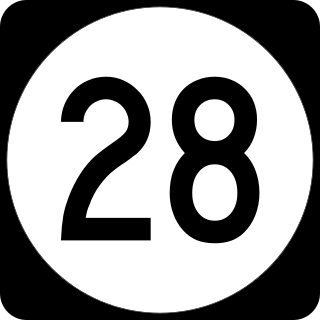Pre-1927 Route 16 was a route in New Jersey that ran from Princeton north to Morristown, existing from 1921 to 1927. Today, it is part of the following routes:
Pre-1927 Route 16 was a route in New Jersey that ran from Princeton north to Morristown, existing from 1921 to 1927. Today, it is part of the following routes:

Route 28 is a state highway in the central part of New Jersey, United States that is 26.44 mi (42.55 km) long. Its western terminus is at U.S. Route 22 in Bridgewater Township, Somerset County while its eastern terminus is at Route 27 in Elizabeth, Union County. From its western terminus, Route 28 heads east through Raritan, intersecting County Route 567 and then U.S. Route 202 and U.S. Route 206 at the Somerville Circle before heading through the central part of Somerville. Past Somerville, the route interchanges with Interstate 287 in Bridgewater Township before intersecting many 500-series county roads including County Route 525 and County Route 527 in Bound Brook, County Route 529 in Dunellen, Middlesex County, County Route 531 in Plainfield, Union County, and County Route 509 in Westfield. Route 28 continues east, intersecting Route 59 and the Garden State Parkway in Cranford before heading to Elizabeth, where it crosses Route 439 before ending at Route 27. Route 28 is a two- to four-lane road its entire length that passes through suburban areas and runs within a close distance of New Jersey Transit’s Raritan Valley Line for much of its length.
In the U.S. state of New Jersey, the New Jersey Department of Transportation (NJDOT) maintains a system of state highways. Every significant section of roadway maintained by the state is assigned a number, officially State Highway Route X. Interstate Highways and U.S. Highways are included in the system. State Routes are signed with the circular highway shield.
On January 1, 1953, the New Jersey Highway Department renumbered many of the State Routes. This renumbering was first proposed in 1951 in order to reduce confusion to motorists. A few rules were followed in deciding what to renumber:
Horseshoe is a shoe for horses and by analogy is applied to many things with a similar shape.

U.S. Route 22 is a U.S. highway stretching from Cincinnati, Ohio in the west to Newark, New Jersey in the east. In New Jersey, the route runs for 60.53 mi (97.41 km) from the Easton–Phillipsburg Toll Bridge over the Delaware River in Phillipsburg, Warren County to Interstate 78 (I-78), US 1/9, and Route 21 at the Newark Airport Interchange in Newark, Essex County. The road first heads through the Phillipsburg-Alpha area as a surface divided highway before running concurrent with I-78 through mountainous and agricultural sections of western New Jersey between Alpha and east of Clinton in Hunterdon County. For the remainder of the route, US 22 runs to the south of I-78 through mostly suburban areas as a four- to six-lane surface divided highway, passing through Hunterdon, Somerset, Union, and Essex counties. Along this portion, it intersects US 202 and US 206 in Somerville, I-287 in Bridgewater Township, and the Garden State Parkway in Union.
Pre-1927 Route 4 was a route in New Jersey that ran from Absecon north to Rahway, existing from 1916 to 1927. Today, it is part of the following routes:
Pre-1927 Route 18 was a route in New Jersey that ran from Camden east to Toms River, existing from 1923 to 1927. Today, it is part of the following routes:
Pre-1927 Route 14 was a route in New Jersey that ran from Cape May north to Egg Harbor City, existing from 1917 to 1927. Today, it is part of the following routes:
Pre-1927 Route 6 was a route in New Jersey that ran from Camden south to Mullica Hill, where it headed southwest to Salem, southeast to Bridgeton, and north back to Mullica Hill. The route existed from 1922 to 1927. Today, it is part of the following routes:
Pre-1927 Route 7 was a route in New Jersey that ran from Hightstown east to Asbury Park, existing from 1916 to 1927. Today, it is part of the following routes:
Pre-1927 Route 8 Spur was a route in New Jersey that ran from Dingman's Ferry east to Franklin Furnace, existing from 1926 to 1927. Today, it is part of the following routes:
Pre-1927 Route 15 was a route in New Jersey that ran from Bridgeton east to Rio Grande, existing between 1917 and 1927. Today, it is part of the following routes: